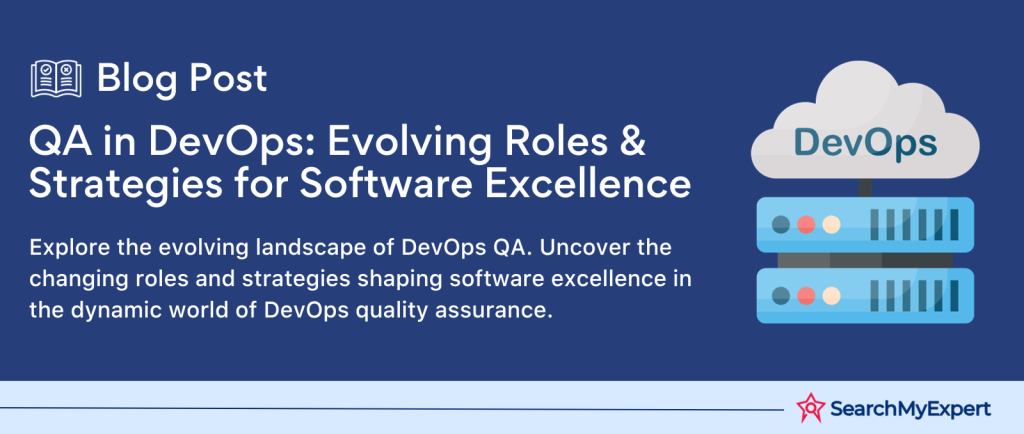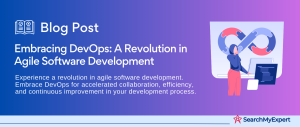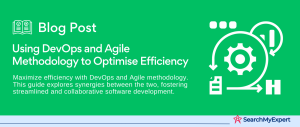The Role of QA in DevOps
DevOps: Redefining Software Development
DevOps is more than a methodology; it’s a cultural and professional movement that emphasizes collaboration, communication, integration, and automation among software developers and IT operations teams. The primary goal is to shorten the systems development life cycle while delivering features, fixes, and updates frequently in close alignment with business objectives. Key principles of DevOps include:
- Continuous Integration & Continuous Delivery (CI/CD):
Streamlining software development and deployment. - Automation:
Minimizing manual processes to enhance efficiency. - Collaboration:
Encouraging open communication and collaboration between teams. - Monitoring & Feedback:
Continuous monitoring of applications and infrastructure with prompt feedback mechanisms.
Traditional Role of QA in Software Development
In traditional software development, Quality Assurance (QA) plays a critical role in ensuring the final product is free from defects and meets quality standards. Historically, QA’s role involves:
- Testing:
Conducting various tests to identify bugs and issues. - Validation:
Ensuring the product meets the defined requirements. - Documentation:
Creating detailed reports of the testing process and outcomes.
Need for a Shift in QA’s Role in DevOps
However, with the advent of DevOps, the role of QA is experiencing a paradigm shift. In a DevOps environment:
- Integration: QA must be integrated into the entire software development lifecycle, not just at the end.
- Automation:
Testing processes need to be automated to keep pace with continuous development and deployment. - Collaboration:
QA professionals are expected to work closely with developers and operations, blurring the traditional boundaries.
This integration of QA into DevOps signifies a major change from being just gatekeepers of quality to active participants in the development process, ensuring quality at every stage of the software lifecycle.
Paradigm Shift – From Gatekeeper to Collaborator
Traditional QA: The Gatekeeper Mentality
In the traditional software development lifecycle, QA often functions as the final checkpoint before a product’s release. This “gatekeeper” mentality positioned QA teams at the end of the development process, where they:
- Checked for Compliance: Ensuring the product met pre-defined standards.
- Focused on Fault-Finding:
Primarily identifying bugs and errors. - Operated Separately:
Working in isolation from development and operations teams.
DevOps QA: The Collaborative Approach
DevOps introduces a paradigm shift in how QA is perceived and integrated. In this ecosystem, QA becomes a collaborative endeavor, characterized by:
- Shared Responsibility:
Quality is a collective responsibility of developers, QA teams, and operations. - Continuous Involvement: QA is involved throughout the development lifecycle, not just at the end.
- Proactive Problem-Solving: Emphasis on preventing issues rather than just finding them post-development.
Continuous Feedback Loops and Integrated Testing
A critical element of this shift is the establishment of continuous feedback loops and integrated testing:
- Early and Ongoing Testing: QA starts at the beginning of the development cycle and continues throughout.
- Real-Time Feedback:
Developers and QA teams work closely, sharing insights and feedback in real-time. - Automated Testing: Automation tools are used to speed up testing processes and ensure consistency.
The Importance of Early and Frequent Testing
In DevOps, early and frequent testing is crucial for several reasons:
- Quick Identification of Issues: Early testing helps in identifying and addressing issues before they escalate.
- Seamless Integration:
Regular testing ensures new features integrate smoothly with existing systems. - Reduced Development Time:
Continuous testing accelerates the development process by minimizing the time spent on fixing bugs post-development.
The evolution from gatekeeper to collaborator in QA reflects a broader change in software development culture – one that values ongoing involvement, shared responsibility, and proactive problem-solving.
Embracing Automation and Tools
The Rise of Automated Testing in DevOps
Automation stands as a pillar in the DevOps culture, reshaping how testing is performed. In DevOps, automated testing is not just a convenience; it’s a necessity. This shift is characterized by:
- Speed and Efficiency:
Automated tests execute faster and more frequently than manual testing. - Consistency and Reliability:
Automation eliminates human error, ensuring consistent results. - Scalability:
Automated tests can easily be scaled to cover more scenarios and features.
CI/CD Pipelines: The Backbone of DevOps
Continuous Integration and Continuous Delivery (CI/CD) pipelines form the backbone of DevOps, offering several benefits:
- Streamlined Workflow:
CI/CD pipelines automate the software delivery process, from code integration to deployment. - Rapid Feedback and Iteration:
They enable quick feedback, allowing teams to iterate and improve continuously. - Enhanced Collaboration: These pipelines foster collaboration, as all team members can view the progress and contribute.
QA’s Role in Automated Test Suites
QA plays a pivotal role in the design and implementation of automated test suites in DevOps:
- Test Planning and Design:
QA teams are instrumental in planning and designing test cases and scenarios. - Selection of Tools: They help in selecting the right tools that align with the project needs and objectives.
- Maintenance and Improvement:
QA continuously monitors, updates, and improves the test suites to adapt to new requirements and challenges.
Embracing automation and tools in DevOps is not just about replacing manual processes but about enhancing efficiency, consistency, and collaboration in the software development lifecycle.
Bridging the Gap – Collaborating with Developers and Operations
Close Collaboration with Developers
In the DevOps model, QA’s collaboration with developers is more intimate and involved. This collaboration manifests in various forms:
- Pair Programming:
QA professionals and developers often engage in pair programming, where they work together on the same code. This practice not only improves code quality but also enhances the understanding of each other’s perspectives. - Code Reviews:
QA participates in code reviews to provide early feedback, ensuring that potential issues are addressed before they escalate.
Working Hand-in-Hand with Operations
The collaboration extends to operations teams, particularly in areas like performance and security testing:
- Performance Testing: QA works with operations to test and optimize the software’s performance, ensuring it meets the required standards under real-world conditions.
- Security Testing:
QA and operations collaborate to ensure the software’s security, identifying vulnerabilities and ensuring compliance with security standards.
Shared Ownership: A Core Tenet of DevOps
Perhaps the most significant aspect of QA’s role in DevOps is the shared ownership of quality:
- Collective Responsibility: Quality is not the sole domain of any single team. Developers, QA, and operations all share the responsibility for the final product’s quality.
- Holistic Approach:
This shared responsibility encourages a more holistic approach to software development, where quality is considered at every stage, from design to deployment.
This collaborative model in DevOps bridges traditional gaps, fostering a culture where quality is a collective pursuit, deeply integrated into every aspect of the development process.
Beyond Bug Finding – Shift to Quality Advocacy
A Proactive Approach to Quality Assurance
In the DevOps paradigm, QA transcends the traditional bug-finding role to become advocates for quality. This proactive approach involves:
- Preventive Measures:
Identifying potential problem areas early in the development cycle. - Continuous Improvement: Constantly seeking ways to enhance the quality of both the process and the product.
Advanced Techniques in QA
In pursuit of quality, QA employs advanced techniques such as:
- Risk-Based Testing:
Prioritizing tests based on potential risks, focusing on critical areas that could have the most significant impact. - User Experience (UX) Testing:
Ensuring the product not only works flawlessly but also delivers a superior user experience.
Promoting a Culture of Quality
One of QA’s most crucial roles in DevOps is to foster a culture of quality:
- Advocacy and Leadership:
QA leads by example, advocating for best practices and high standards throughout the team. - Educating and Influencing:
Providing guidance and insights to other team members about the importance of quality. - Collaborative Environment:
Encouraging open communication and collaboration that contribute to overall quality.
By embracing these roles and techniques, QA becomes a vital force in driving quality throughout the DevOps process, moving far beyond just finding bugs.
Measuring Success – Metrics and KPIs for QA in DevOps
Key Metrics and KPIs in DevOps QA
In DevOps, measuring the success and effectiveness of QA is critical. This involves tracking various metrics and Key Performance Indicators (KPIs) such as:
- Test Coverage:
Measures the amount of testing performed, covering different aspects of the software. - Defect Escape Rate: Tracks the number of defects found post-release versus those identified during testing.
- Lead Time to Resolution:
Time taken to resolve issues from the moment they are identified. - User Satisfaction:
Gauges the end-user’s satisfaction with the product, reflecting the software’s quality and usability.
The Power of Continuous Feedback and Data Analysis
In a DevOps environment, continuous feedback and data analysis are vital for:
- Identifying Improvement Areas:
Ongoing feedback helps in pinpointing areas that need attention. - Data-Driven Decisions: Data analysis enables informed decision-making about where to focus QA efforts.
- Iterative Improvement: The continuous cycle of feedback and analysis fosters an environment of constant refinement and improvement.
By effectively tracking these metrics and harnessing the power of continuous feedback, QA in DevOps becomes a data-driven, results-oriented function, crucial for the continuous enhancement of quality processes.
The Future of QA in DevOps – Continuous Learning and Growth
The Imperative of Continuous Learning
In the rapidly evolving landscape of DevOps, continuous learning and adaptation are not just beneficial for QA professionals; they are essential. This necessity arises from:
- Evolving Technologies: Keeping pace with the latest tools, practices, and methodologies.
- Changing Role:
Adapting to the increasingly strategic and proactive role of QA in DevOps.
Emerging Trends in QA
The future of QA in DevOps is being shaped by several key trends:
- AI-Powered Testing: Leveraging artificial intelligence to enhance testing efficiency and accuracy.
- Advanced Automation Tools: Utilizing sophisticated tools for more complex testing scenarios and analytics.
- Integration of New Technologies: Incorporating technologies like machine learning, IoT, and cloud computing into testing processes.
Conclusion
The role of QA in DevOps is not just changing; it’s evolving to become more critical than ever. QA professionals are not just testers; they are quality advocates, strategists, and innovators. As DevOps continues to redefine software development, QA stands at the forefront, driving quality, efficiency, and continuous improvement. The future of software development relies heavily on the skills, insights, and adaptability of QA professionals.
Accelerate your deployment with our DevOps Services.
Table of Contents
Toggle






